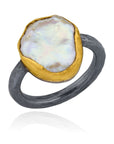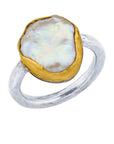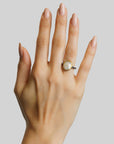


Lika Behar Keski Pearl 24kt Bezel Ring
Description
From Turkish jewelry designer Lika Behar, this beautiful Keshi pearl ring features a 13-14mm Keshi pearl set in 24k yellow gold, carefully set with a sterling silver or oxidized sterling silver band.
*Because every Keshi pearl is unique, the physical characteristics of this ring may not exactly match the photo.
Details
- 24k yellow gold & oxidized sterling silver or sterling silver
- Keshi pearl
- Choose from Ready to Ship options or reach out for sizing and metal availability
Style# KARIN24-R-104-GWPE
- All orders are eligible for free shipping
- Call us at 541-345-0354 if you require next day shipping (additional fees apply)
- Please allow 1-2 days to process your order and prepare shipment
- We only ship to addresses within the United States. We are unable to process orders shipped to package forwarding services at this time.
At Skeie's, it's of upmost importance that the jewelry we select is obtained from suppliers who follow conflict-free and socially responsible practices. We believe that the materials used in our jewelry should support and benefit the communities where they originated, while keeping the environmental impact as minimal as possible.
Compliments of Skeie's Jewelers
our signature gift wrap
Skeie's Favorites
curated collections
Artful, sophisticated pieces designed and selected with you in mind. Details that have been poured over by our team of artists, jewelers, gemologists, and designers. Gemstones, meticulously chosen to represent the beauty and versatility of heirloom jewelry.
THE SKEIES EXPERIENCE
Frequently Asked Questions
We take all jewelry and watches in for review and estimation before beginning any work; the review is complimentary and we will always approve estimates with you before we begin any work.
We cannot give price estimates over the phone or online, as every piece can var
We have a team of expert goldsmiths and jewelers on site, and can work on a large range of repair needs.
Common repairs include ring sizing, polishing, rhodium plating, adjusting chain length, replacing clasps, re-stringing services, and more.
There is no appointment necessary to drop off your items for review and estimates.
Since we're located in Eugene, Oregon, we do NOT charge sales tax. The prices you see are the prices you pay!
We offer free shipping on all orders over $500. Our standard shipping is 2-7 days; all items are fully insured and require a signature upon delivery.
Articles are accepted for credit or exchange in the U.S. if returned in salable condition within 30 days, accompanied by a sales receipt. Some exclusions may apply.
@skeiesjewelers
SHOP OUR INSTAGRAM















